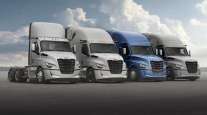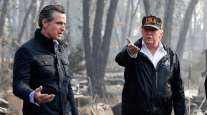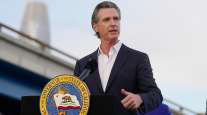Staff Reporter
California Strengthens Alliances for Transportation Electrification

[Stay on top of transportation news: Get TTNews in your inbox.]
The governor of California is strengthening a clear energy partnership with two neighboring states and British Columbia.
“The West will continue to lead the way toward a carbon-free future that supports our economy, our people and our planet,” Gov. Gavin Newsom said Oct. 6 in San Francisco during a signing ceremony for a statement of cooperation between Oregon Gov. Kate Brown, Washington Gov. Jay Inslee and British Columbia Premier John Horgan.
Encompassing a region with 57 million people and a $3.5 trillion combined gross domestic product, the four governments belong to the Pacific Coast Collaborative. The effort, formed in 2013, works toward advancing clean energy and a low-carbon economy in key sectors of the region, notably Los Angeles, San Francisco, Oakland, Portland, Seattle and Vancouver.
West Coast Strong — it is a privilege to stand alongside @CAgovernor, @GovInslee, and Premier @jjhorgan to continue fighting the climate crisis.
The West Coast is united as we lead the way towards a clean energy future that will help our entire region and economies thrive. pic.twitter.com/rpN8K6avPh — Governor Kate Brown (@OregonGovBrown) October 8, 2022
“The West Coast is united as we lead the way toward a clean energy future that helps our entire region and economies to thrive,” said Brown. “In Oregon, we have set ambitious goals to reach 100% clean energy sources, reduce carbon emissions and comprehensively address climate change.”
The Pacific Coast Collaborative has included a low-carbon transportation road map among its priorities. It has previously outlined a focus on goods transportation, including low-carbon technologies and infrastructure for medium- and heavy-duty vehicles, and also supports new and innovative technologies.
The new agreement specifies that the three states and Canadian province will collaborate on climate change actions such as investing in infrastructure like electric vehicle charging stations and green ports.
The pact also aims to promote development of a clean-energy electric grid and to protect communities from climate-related drought, wildfires, heat waves and sea-level changes.
“Our partnerships speak to just how diverse and interconnected the green energy economy has already become. We know where it goes from here — onward to a cleaner, cheaper and more efficient energy economy that averts climate calamity at the same time,” Inslee remarked.

Work is already underway on the West Coast Electric Highway, which would locate direct current fast-charging stations every 25 to 50 miles along Interstate 5, U.S. Route 99 (the Golden State Highway) and other major roads in California, Oregon, Washington and British Columbia. Canadian efforts in the province are to be coordinated under the PlugInBC program.
“Working together, we’re charting a path to a cleaner, stronger future with good jobs and opportunities — for people on both sides of the border,” Horgan said.
The three U.S. states are also holding discussions with other Western states about “transitioning to a Western regional grid operator that would provide clean energy and other benefits to each state and the region, while respecting the energy policy preferences of each state and the needs and interests of non-participating utilities.”
This year, California has entered into a series of international bilateral pacts, including memorandums of cooperation with Canada, Japan and New Zealand as well as memorandums of understanding with China and the Netherlands.
Each agreement signed by Newsom and other global representatives contains different features.
Noting that the Netherlands and California are “global leaders” in transportation electrification and EV adoption, the bilateral agreement the pair signed Sept. 6 identifies zero-emission mobility, freight and EV charging as key. Both parties intend to share information and best practices on actions to reduce emissions at ports from trucks, ocean-going vessels, harbor craft and port equipment. Also of interest is information about renewable energy, infrastructure and clean fuels to lower emissions at ports.
CA can't tackle climate change alone - which is why we are working with our partners in @PCCleads to:
Support our most climate-impacted communities
Invest in climate infrastructure
Protect communities from wildfire, drought, heat waves, flooding & more pic.twitter.com/JHBCFXYHnt — Office of the Governor of California (@CAgovernor) October 6, 2022
One element of the agreement California signed June 9 with Canada targets sharing technical data and information about targets for emissions and zero-emission vehicle emissions regulation targets for light-, medium- and heavy-duty vehicles and off-road equipment, as well as incentive programs and low-carbon fuels.
The state on May 27 agreed to exchange ideas with New Zealand on transportation electrification and work with the private sector to overcome supply chain constraints, trade barriers and/or increase the production volumes of zero-emission technologies. Another area of interest is emissions trading ideas to share best practices in developing “market-based programs and carbon pricing instruments.”
Focal points between California and China in an agreement signed in April are to enhance transportation-related air pollution control strategies, increase electrified transportation and expand markets for technologies in energy-intensive industries and transportation.
California’s March 21 pact with Japan targets exploring investments in clean energy electricity storage, particularly large-scale hydrogen production and zero-emission vehicles. One area of exploration is about accelerating the rollout of battery EVs and fuel cell EVs, including hydrogen fueling infrastructure.
Want more news? Listen to today's daily briefing below or go here for more info:




